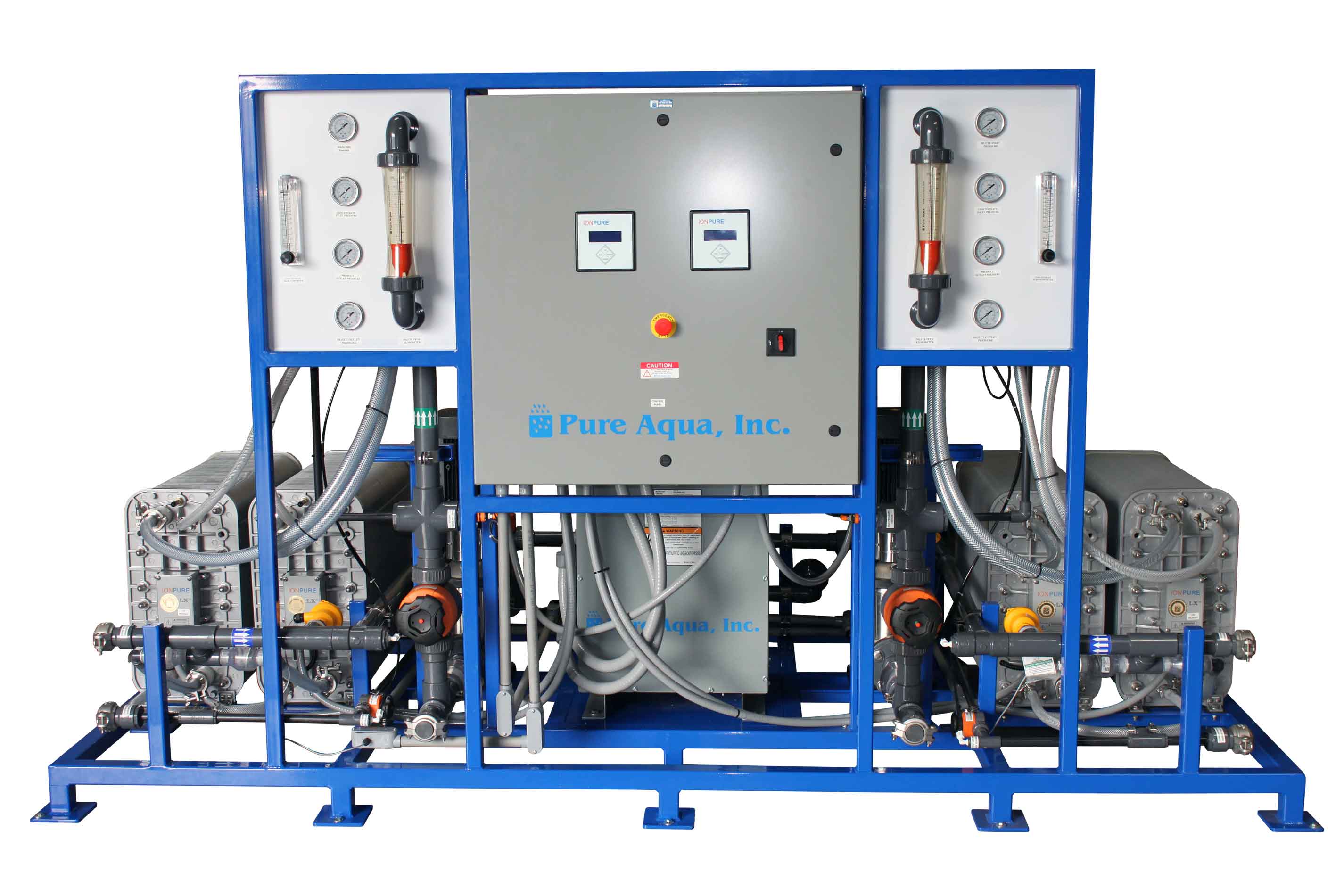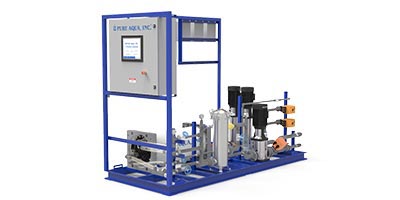EDI System In Water Treatment
Electrodeionization works in applying functional currents to eradicate ionized substances from water bodies, while simultaneously regrowing the ion exchange media. An EDI water system is usually applied after the usage of a reverse osmosis system or even a double pass ro system.
EDI water treatment help to guarantee that every part of the system will perform perfectly together. What results is an extremely purified solution that meets all of your requirements.
- Reduced chemical use
- Lower capital costs
- Compact design (saves space)
- Environmentally friendly
- Minimal maintenance
- Very consistent operation
Service Flow Rates:
2 to 220 GPM
(0.5 to 50 M³/hr)
- No Chemical Regeneration
- Small, Compact Modules
- Produces Water up to 18 Megaohm-cm
Pure Aqua has over 20 years of experience as a global supplier in producing electrodeionization systems for greater purity and support across many industries with cutting-edge solutions in water treatment. Reliability, high quality, and no need for chemical regeneration make our EDI systems extremely desirable in the market.
EDI systems remove ionized and ionizable species from water using electrically active media and electrical potential (DC power) to affect ion transport. By using this type of purification technology, caustic and acidic types of chemicals are not required. The water which has been treated by RO-EDI has typically exceeded customer’s high-purity standards.
Electrodeionization system is a continuous electro-chemical process of water deionization where ion specific membranes, mixed bed resin and a DC voltage across them, replace the standard hazardous acid-caustic chemical regeneration process.

In the latest technology of EDI, modules must be pretreated with RO for many reasons. However, what are the advantages and disadvantages of softening and 1-pass and 2-pass RO as pretreatment?
Many EDI water systems in water treatment using Pure Aqua EDI technology perform very well with 1-pass RO. It is easy to achieve 17+ Megaohm with 1-pass RO. Most USP WFI and purified water systems easily meet requirements with 1-pass RO. As a basic knowledge in the water treatment industry, softening with 1-pass RO system is less expensive and less complex than a 2-pass RO system.
Two pass RO followed by EDI gives the following advantages, and is often used for power plants or pharmaceutical applications.
-
Lower conductivity = higher EDI quality
-
Lower CO2 = higher silica removal
-
ppb-level contaminants means infrequent EDI cleaning
-
Higher rated flows for EDI
Single pass RO system can be enhanced using membrane degasser for even better EDI performance. Membrane degasser can reduce the CO2 which enhances EDI performance, reduces scaling potential, and helps SiO2 removal by the EDI machine.
In summary, EDI water systems have many options:
- Softener followed by RO followed by EDI modules
- Softener followed by RO followed by membrane degasser followed by EDI modules
- RO followed by caustic dosing followed by RO followed by EDI modules
It is difficult to meet the feed specification to the EDI water treatment plants without pH adjustment and/or membrane degasser. Decreasing the CO2 before the electrodeionization system will decrease the load (lower amps) and improve the product quality. Pure Aqua installed a membrane degasser on many EDI skids for CO2 removal/reduction. The membrane degasser replaced the proposed design of a conventional forced air degasser (tower). It was more cost efficient, compact and decreases installation time.
What is electrodeionization?
Electrodeionization is a green solution used to remove ions from water with an electrically active media, without the use of chemicals. This process creates ultra pure water through combining ion exchange water filters with electrical potential (DC power). Electric potential regenerates resin with less cost, since it only requires electricity, while conventional ion exchange water treatment systems need large vessels, acid/caustic injection systems, and etc. EDI water treatment is also useful in cleaning RO permeate.
How does electrodeionization work?
Electrodeionization is designed to polish the permeate once the water has already went through a water treatment system, such as reverse osmosis. This system utilizes low energy consumption and disposes of the need for costly and unsafe chemicals used in conventional ion exchange water filters. Such factors make operation expenses much lower, and helps water treatment companies meet their environmental protection quotas.
Do EDI Systems have a difficult time removing CO2?
Unlike RO systems, EDI water treatment is capable of removing CO2 concentration from feed water. This is importance since carbon dioxide is seemingly ionized in water, which makes its concentration unable to be measured by conductivity measurement. Additionally, since RO systems are incapable of eradicating carbon dioxide, this leaves a significant dependence on the EDI water system to do it.
 ENGLISH
ENGLISH ESPAÑOL
ESPAÑOL العربية
العربية PORTUGUÉS
PORTUGUÉS FRANÇAIS
FRANÇAIS

